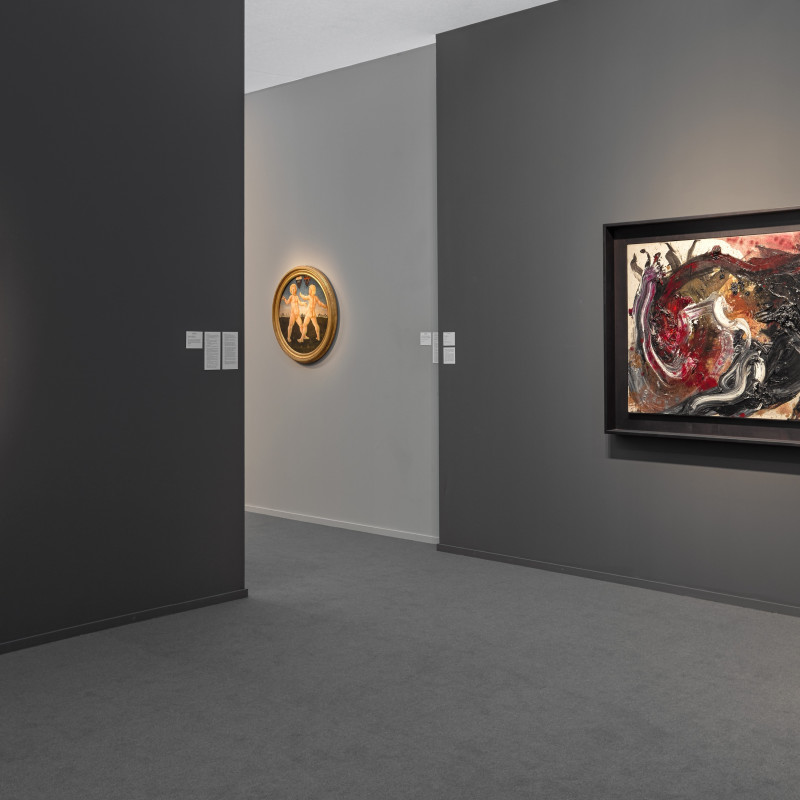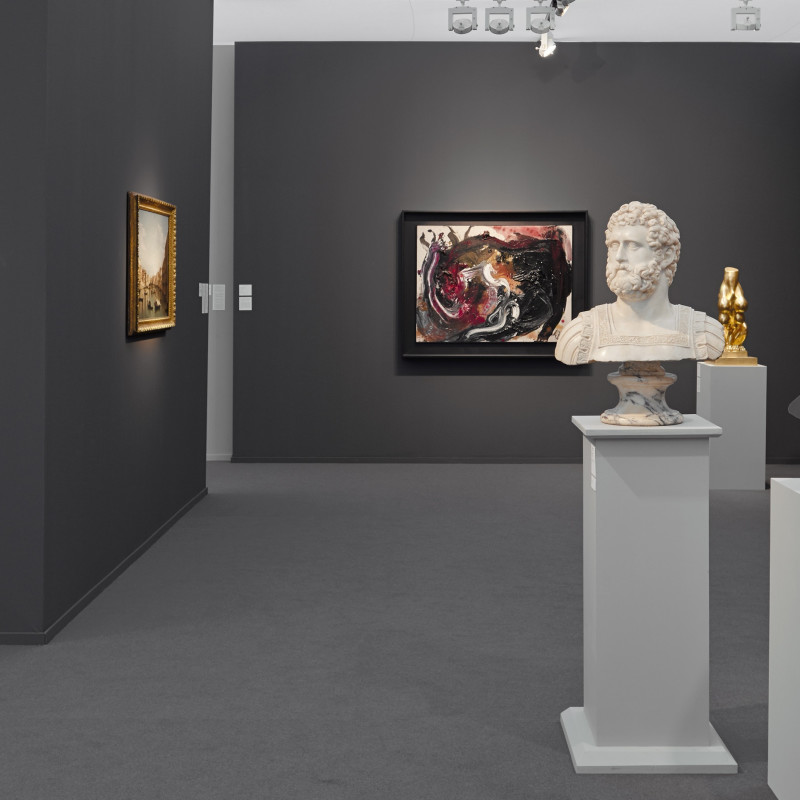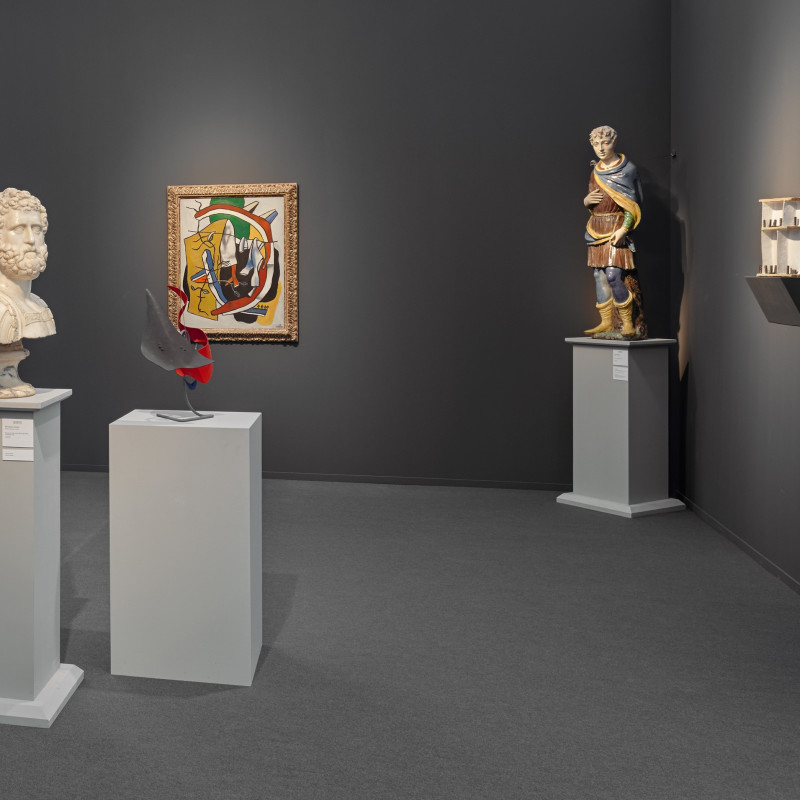Hauser & Wirth and Moretti Fine Art
present collaborative booth at Frieze Masters
Frieze Masters, Booth D1
14 – 18 October 2015
Regent’s Park, London
On the occasion of Frieze Masters 2015, Hauser & Wirth and Moretti Fine Art are pleased to announce that they will present a collaborative booth, revealing the essence of an ideal collection by drawing together works spanning centuries, with 14th-century Italian panels presented alongside the likes of Hans Arp, Louise Bourgeois, Henry Moore and Francis Picabia.
This unique conceptual presentation seeks to dissolve the reductive boundaries of genre. In this way, the collaboration between both galleries echoes the spirit of Frieze Masters – appealing to an eclectic art lover who embraces art from any period and on all levels.
The selection of paintings and sculptures from Moretti Fine Art is representative of the finest European art between 14th- and 18th-century. Highly decorative and rich in symbolism, these masterworks from names such as Andrea della Robbia (1435 – 1525) and Bernardo Bellotto (1721 – 1780) include luminous gold- ground panel paintings, classical marble reliefs and terracotta statues.
The modern and contemporary works shown by Hauser & Wirth complement the Italian Old Masters; the entire presentation is united by themes of spirituality, maternal relationships, human sacrifice, nature and contemplation of man’s existence. In many cases, abstraction emerges as the passage to a modern definition of the sublime – in the reduction of form and exploration of shape, colour and line, these artists seek to evoke a strong emotional, even quasi-religious, experience.
For Louise Bourgeois, the process of making art was a means of transmitting and expelling emotion into her artistic materials, a form of cathartic sublimation. Birth, motherhood, sexuality and human relationships, specifically the life-changing experience of childbirth and the fragile emergence of new life, were themes that preoccupied Bourgeois for many years. ‘Quarantania III’ (1949) is part of Bourgeois’s series of Personnages sculptures. Presented in a group, the geometric figures translate an existential anxiety at the limitations of human and familial communication. These life size effigies are, despite the simplicity of the forms that have been used to conjure them, personalities, and as such are deeply personal facets of Bourgeois’s experience as a mother and her wider personal relationships.
Francis Picabia’s ‘Femme nue avec statue’ (1937) is a sombre contemplation of the human condition, painted in the shadow of the imminent outbreak of World War II and seperation from his wife. A totemic sculptural figure looms next to a classical female nude, and is the subject of her gaze, reflective of the contemporary fixation with primitivism as an attempt to decipher the essence of life and art. ‘Femme nue avec statue’ belongs to a series of naturalistic paintings that immediately followed Picabia’s seminal series of Transparencies. In this new style, the aesthetic refinement of the Transparencies was succeeded by a direct, poster-like brutalism that sought to achieve great power of expression through a simplification of subject and form. Picabia’s application of a faux antique glaze and craquelure surfaces draws attention to the contrast between his primitive subject matter and that of Old Master works that traditionally employed this technique.
‘Magdalena’ (1996) forms part of Marlene Dumas’ series based on the biblical character of Mary Magdalene. Dumas’ Magdalena takes centre-stage, exposed against a stark white background. Stripped of any context, she appears like a ghostly beacon, a symbol of lust and power that is both seductive and yet ultimately untouchable. Born in a moment of fleeting physical encounter between the artist and the paper, hovering on the edge of abstraction with their liquefied colours still bleeding across the page, these apparitions are ethereal records of the artist’s touch.
Hans Arp’s ‘Hurlou sur Socle-colonne’ (1951 – 1964) is a seminal example of the artist’s approach to sculpture in his later period, revealing an exploration of form through a sensual language of opposites – solid and void, presence and emptiness, human and nature. The sculpture is a singular, organic form that both draws on and transcends sculptural abstraction and the history of art, becoming autonomous and placeless, freed from commissions with an intrinsic beauty of its own.
Fausto Melotti found a sublime harmony in the principles of geometry, mathematics and musical structure. In the 1960s, the artist developed a sculptural language made of delicate threads and thin sheets of brass, iron and gold. ‘Tramonto Kitsch’ [Sunset Kitsch] (1977) followed this transformational period. Adding the classical components of rhythm, order and harmony to the minimalist, conceptual reality of sculpture, the work exemplifies Melotti’s newfound vision of delicately wrought, almost fragile constructions, enriched by a new narrative that is at once dream-like, symbolic and poetic.
Much of Hermann Nitsch’s work of the 1960s aspired to the most intense experiences, embracing Dionysian excess, but also profound contemplation and transcendence. Calling to mind associations to the human body, the intestines, the vulva and the blood, ‘Untitled’ (1960) speaks to invocations of ancient myths and religious sacrifice. Nitsch allowed molten streaming wax to drip and congeal, creating shapes evocative of human orifices, linking the body with metaphysical histories such as the blinding of Oedipus, or the crucifixion and sacrificial death of Christ.
The range of material to be exhibited by Moretti is impressive, beginning with devotional art from the early Tuscan and Venetian Schools, such as the profoundly moving images of Madonna and Child on luminous gold-grounds by Luca di Tomme and Bartolomeo Vivarini. Other early treasures include an elegant Saint Catherine by Barnaba da Modena and the exquisitely carved marble relief by ‘The master of the Piccolomini Madonna’. The later Italian Schools include the recently re-discovered ‘Portrait of Tommaso de Bardi’ by Alessandro Allori, a ‘Mannerist’ painter whose style perfectly reflects the taste of mid-16th-century Florence. The selection ends with an early masterpiece by Bernardo Bellotto – ‘View of the Grand Canale Looking South from the Palazzo Foscari’, a view commissioned by Henry Howard, 4th Earl of Carlisle, in 1738, which has remained at Castle Howard until recently. Highlights are as follows:
Born into one of the most influential families of Venetian painters, Bartolomeo Vivarini (ca. 1432 – 1499) is celebrated for his carefully composed, detailed and highly finished compositions. The ‘Madonna and Sleeping Child’, seen in a winding river landscape against a glowing gold background, is painted with a richness of colour and sharp perspective, which characterises the artist’s finest manner.
The ‘Formella with heraldic arms’ by Andrea della Robbia (1453 – 1525) is an extremely well preserved example of the glazed terracotta reliefs created in Florence during the Renaissance. Andrea’s technical brilliance in producing such objects, exemplified here by a fine sculptural quality and liveliness of colour, demonstrate his distinctive artistic personality within the prolific Della Robbia workshop.
Preserved in excellent condition, the relief of the ‘Madonna and Child’ is one of a series of nine versions in marble which repeat the same central motif and which have been grouped around a single artist, now referred to as the ‘Master of the Piccolomini Madonna’ (ca. 1450 – 1475). Perhaps deriving from a lost original by Donatello, the sculptures – with variants in the Victoria and Albert Museum in London and in the Musée du Louvre in Paris – are generally assumed to have been carved in Siena.
One of the most prolific painters in late 16th-century Florence, Alessandro Allori (1535 – 1607) was trained in Agnolo Bronzino’s workshop in Florence. Hitherto only known through a preparatory drawing traditionally attributed to Bronzino (British Museum, London), the signed ‘Portrait of Tommaso de Bardi’ is a remarkable rediscovery. The picture displays the complicated twisting poses typical of Allori’s ‘Mannerism’, which influenced artistic developments in Florence for decades after his death.
Among the earliest examples of works by Bernardo Bellotto (1722 – 1780), the ‘View of the Grand Canale Looking South from the Palazzo Foscari’ bears witness to the precocious talent of the young artist and his rapid development within the studio of his uncle, Canaletto. Commissioned by the 4th Earl of Carlisle for Castle Howard, this veduta is amongst the most important compositions by Bellotto and formed part of the largest group of his pictures to have been purchased by a single patron.
October 10, 2015







